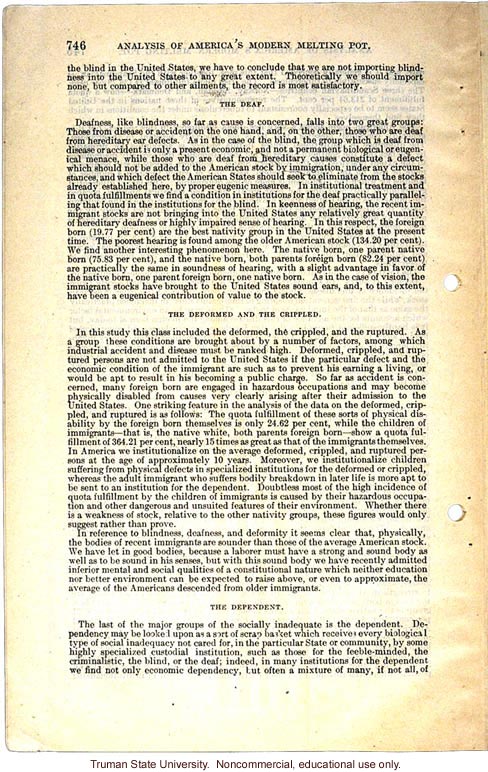"Analysis of America's Modern Melting Pot," Harry H. Laughlin testimony before the House Committee on Immigration and Naturalization (13)

"Analysis of America's Modern Melting Pot," Harry H. Laughlin testimony before the House Committee on Immigration and Naturalization (13)
1136. 746 Analysis of America's Modern Melting Pot. the blind in the United States, we have to conclude that we are not importing blindness into the United States to any great extent. Theoretically we should import none, but compared to other ailments, the record is most satisfactory. The Deaf. Deafness, like blindness, so far as the cause is concerned, falls into two great groups: Those from disease or accident on the one hand, and, on the other, those who are deaf from hereditary ear defects. As in the case of the blind, the group which is deaf from disease or accident is only a present economic, and not a permanent biological or eugenical menace, while those who are deaf from hereditary causes constitute a defect which should not be added to American stock by immigration, under any circumstances, and which defect the American States should seek to eliminate from the stocks already established here, by proper eugenic measures. In institutional treatment and in quota fulfillments we find a condition in institutions for the deaf practically paralleling that found in the institutions for the blind. In keenness of hearing, the recent immigrant stocks are not bringing into the United States any relatively great quantity of hereditary deafness of highly impaired sense of hearing. In this respect, the foreign born (19.77 per cent) are the best nativity group in the United States at the present time. The poorest hearing is found among the older American stock (134.20 per cent). We find another interesting phenomenon here. The native born, one parent native born (75.83 per cent), and the native born, both parents foreign born (82.24 per cent) are practically the same in soundness of hearing, with a slight advantage in favor of the native born, one parent foreign born, one native born. As in the case of vision, the immigrant stocks have brought to the United States sound ears, and to this extent, have been a eugenical contribution of value to the stock. The Deformed and the Crippled. In this study this class included the deformed, the crippled, and the ruptured. As a group, these conditions are brought about by a number of factors, among which industrial accident and disease must be ranked high. Deformed, crippled, and ruptured persons are not admitted to the United States if the particular defect and the economic condition of the immigrant are such as to prevent his earning a living, or would be apt to result in his becoming a public charge. So far as accident is concerned, many foreign born are engaged in hazardous occupations and may become physically disabled from causes very clearly arising after their admission to the United States. One striking feature in the analysis of data on the deformed, crippled and ruptured is as follows: The quota fulfillment of these sorts of physical disability by the foreign born themselves is only 24.62 per cent, while the children of immigrants -- that is, the native white, both parents foreign born - show a quota fulfillment of 364.21 per cent, nearly 15 times as great as that of the immigrants themselves. In America we institutionalize on the average deformed, crippled, and ruptured persons at the age of approximately 10 years. Moreover, we institutionalize children suffering from physical defects in specialized institutions for the deformed or crippled, whereas the adult immigrant who suffers bodily breakdown in later life is more apt to be sent to an institution for the dependent. Doubtless most of the high incidence of quota fulfillment by the children of immigrants is caused by their hazardous occupation and other dangerous and unsuited features of their environment. Whether there is a weakness of stock, relative to the other nativity groups, these figures would only suggest rather than prove. In reference to blindness, deafness, and deformity it seems clear that, physically, the bodies of recent immigrants are sounder than those of the average American stock. We have let in good bodies, because a laborer must have strong and sound body as well as to be sound in his senses, but with this sound body we have recently admitted inferior mental and social qualities of a constitutional nature which neither education nor better environment can be expected to raise above, or even to approximate, the average of the American descended from older immigrants. The Dependent. The last of the major groups of the socially inadequate is the dependent. Dependency may be looked upon as a sort of scrap basket which receives every biological type of social inadequacy not cared for, in the particular State or community, by some highly specialized custodial institution, such as those for the feeble-minded, the criminalistic, the blind, or the deaf; indeed, in many institutions for the dependent we find not only economic dependency, but often a mixture of many, if not all, of
- ID: 11115
- Source: DNALC.EA


